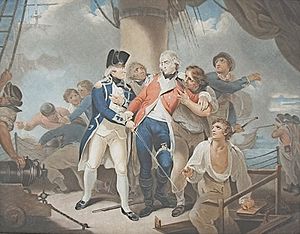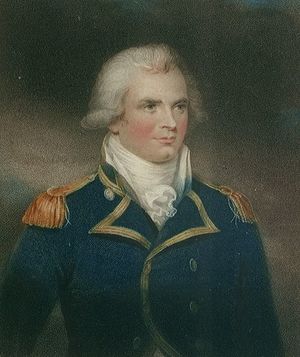HMS Glatton (1795)
 Captain Henry Trollope with the mortally wounded Marine Captain Henry Ludlow Strangeways on the deck of HMS Glatton | |
| Career (UK) | |
|---|---|
| Name: | Glatton |
| Builder: | Wells & Co. of Blackwell |
| Launched: | 29 November 1792 |
| Fate: | Sold to the Royal Navy in 1795 |
| Career (UK) | |
| Name: | HMS Glatton |
| Acquired: | 1795, from East India Company |
| Fate: | Sunk as breakwater, 1830 |
| General characteristics | |
| Sail plan: | Full-rigged ship |
| Armament: |
From 1795:
From 1804: 44 guns |
HMS Glatton was a 56-gun fourth rate of the Royal Navy. She was launched as the Glatton, an East Indiaman, on 29 November 1792 by Wells & Co. of Blackwell. The Royal Navy bought her in 1795 and converted her into a warship. Glatton was unusual in that for a time she was the only ship-of-the-line the Royal Navy armed exclusively with carronades. (Eventually she returned to a more conventional armament.) She served in the North Sea and the Baltic, and then as a transport for convicts to Australia. She then returned to naval service in the Mediterranean. After the end of the Napoleonic Wars the Admiralty converted her to a water depot at Sheerness. In 1830 the Admiralty converted Glatton to a breakwater and sank her at Harwich.
Contents
East India Company service
Glatton made one round trip to China for the East India Company in 1793-4. Her captain was Charles Drummond and her First Lieutenant was William Macnamarra. Drummond had commanded an earlier Glatton and would command a later one too; Macnamarra too would go on to command a later Glatton on a trip to China for the Company.[1]
Captain Henry Trollope commissioned her and it was he that was responsible for her original armament being all carronades instead of the traditional mix of long guns and carronades that other warships carried in this era. His previous command, some eight years earlier, had been the 44-gun Rainbow, which too had been armed entirely with carronades. With her Trollope had in 1782 taken the Hébé, which the British would go to use as the model for the Leda-class frigates.
Carronades had short, relatively thin barrels and so were half the weight of the equivalent cannon. They could be worked by fewer men and could also fire much heavier shot for their weight than a gun of the same overall weight, but at the cost of the accuracy, velocity and range of the shot. This extremely heavy armament meant that the fourth rate Glatton could discharge a heavier broadside than the mighty first rate, Victory. But, in combat with a contemporary opponent, Glatton would have to endure the fire of the enemy's long guns while closing the gap to point-blank range before she could effectively return fire — if indeed the enemy would allow her to approach so close.
Glatton was originally armed with twenty-eight 68-pounder carronades on the lower deck and twenty-eight 42-pounder carronades on her upper deck. All were non-recoil, which is to say that they were fixed to the deck. Within a month 32-pounder carronades replaced the 42-pounders. However, Glatton's ports were too small to allow the larger guns to traverse properly, and she had no bow or stern chasers. Her guns therefore could only be pointed right abeam. After the action in July 1796 (see below), in August 1796 she received two 32-pounders and two 18-pounder carronades for her forecastle. Later, the Navy replaced the 28 68-pounder carronades on the lower deck with twenty-eight 18-pounder long guns.
North Sea and Baltic
Under Trollope, Glatton first served in the English Channel where she engaged a French squadron on 15 July 1796. The French squadron consisted of a 50-gun ship, five frigates (two of 36 guns and three of 28), a brig, and a cutter. Glatton drove the French vessels into Flushing, having lost only two men wounded, one of whom died later, and despite having at times been surrounded by the enemy. The French vessels may have included Brutus (a 74-gun cut down to 46-50 guns), Incorruptible (50 guns), Magicienne (32 guns), and Républicaine, and one French vessel apparently sank in Flushing harbour. (It was in this action that Captain Strangeways of the Royal Marines sustained the wound of which he died shortly thereafter, and which the illustration above commemorates.)
In March-April 1797, Trollope kept Glatton's crew from joining the Nore mutiny. By threatening to fire on the 64-gun Overyssel and the 40-gun Beaulieu, which were in open mutiny, he convinced their crews to return to duty.[2] In August Captain Charles Cobb took command.
Two years later, in August 1799, Glatton participated in the Anglo-Russian Invasion of Holland. The expedition was under the command of Admiral Adam Duncan and the Duke of York. Some 250 craft of all sizes transported 17,000 troops from Margate Roads and the Downs across the Channel on 13 August. Due to bad weather it was 21 August before they anchored off Kijkduin. The next day Vice Admiral Mitchell sent a summons to Vice Admiral Samuel Story, calling on him to surrender his fleet. When he declined, the Duke of York landed his army near Den Helder on 27 August under covering fire from the fleet. Den Helder was occupied the following day when the garrison evacuated the town. The expedition then took possession of 13 old warships laid up in ordinary. On 30 August, Glatton, Romney, Isis, Veteran, Ardent, Belliqueux, Monmouth and Overyssel, a Russian ship and the frigates, anchored in line ahead in the Vlieter and Mitchel again summoned Storij. This time Storij agreed to surrender his squadron of 12 modern warships. The Royal Navy purchased 11 of these. The Dutch surrender, without any resistance, became known as the Vlieter Incident.
On 15 January 1800 a court martial on board the Glatton, in Yarmouth Roads, tried the surviving officers and crew for the loss on the Cockle Sands of the 12-gun brig Mastif as she left Yarmouth Roads via the Northern Passage for Leith. Her captain, Lieutenant James Watson, and eight of his crew had been lost in the incident.[3] The court absolved the accused for the loss of the vessel.[Note 1]
In November, Captain George Stephen took command of Glatton, followed in 1801 by Captain William Bligh, formerly of HMS Bounty. Bligh was only captain for about a month, but during that month he sailed her to the Baltic where Glatton participated in the Battle of Copenhagen. The battle cost her 17 killed and 34 wounded.
Convict transport to Australia
Captain Nathaniel Porlock recommissioned her in May 1802 as a convict ship. Commander James Colnett then assumed command and in September Glatton left England, carrying over 270 male, and 135 female prisoners; of these, seven men and five women died on the journey. She also carried some 30 Free Settlers. She sailed via a resupply stop at Rio de Janeiro to the penal settlement at Sydney, where she arrived on 13 March 1803. When Glatton arrived about 100 of the people on board her were suffering to varying degrees from scurvy.[4]
She then returned to England, arriving on 22 September 1803. Because she returned via Cape Horn, she had circumnavigated the world; her actual time at sea for this feat was 277 days.
Between November and December 1803 she was fitted at Woolwich for service as a man-of-war. Still under Colnett's command, she then served briefly as flagship for Rear Admiral James Vashon. In 1804 Glatton was reduced to a 44-gun fifth rate.
Captain Thomas Seccombe recommissioned Glatton in March 1806 and sailed for the Mediterranean on 22 November. On 23 February 1807, Glatton captured the vessel Madonna. One week later, on 1 March, boats from Glatton and Hirondelle cut out a former French corvette in Turkish service from the port of Sigri on the island of Mitylene. Three days later Glatton captured another Turkish vessel. She then captured a transport off Corfu on 29 November.
Seccombe died in January 1808. He was aboard the brig-sloop Delight when she grounded near Reggio, Calabria. Her crew burnt her to prevent her falling into enemy hands. Seccombe, who had been injured, was removed to Messina and died there. Delight's captain, Commander Phillip Crosby Handfield, late of Egyptienne, and many of his crew were also lost.[5] The surviving crew members became prisoners of war.[6]
Fate
From 1812 to 1814 she was under R. G. Peacock (master) at Portsmouth. In 1814, she was converted into a water depot at Sheerness. Between April and June 1830 she was fitted at Sheerness as a breakwater, and in October Glatton sailed for the last time, to Harwich, where she was subsequently sunk.
Note
References
- Brenton, Edward Pelham (1837) The naval history of Great Britain, from the year MDCCLXXXIII to MDCCCXXXVI. (London: Henry Colburn), vol. 2.
- Colledge, J. J.; Warlow, Ben (2006) [1969]. Ships of the Royal Navy: the complete record of all fighting ships of the Royal Navy (Rev. ed.). London: Chatham. ISBN 9781861762818. OCLC 67375475.
- Grocott, Terence (1997) Shipwrecks of the revolutionary & Napoleonic eras. (London: Chatham). ISBN 1-86176-0302
- Hardy, Charles and Horatio Charles Hardy (1811) A register of ships, employed in the service of the Honorable the United East India Company, from the year 1760 to 1810 with an appendix, containing a variety of particulars, and useful information interesting to those concerned with East India commerce. (London : Black, Parry, and Kingsbury).
- Stephen (Sir Leslie), Sir Sidney Lee, Robert Blake, Christine Stephanie Nicholls (1921) The Dictionary of national biography. (London: Oxford Univ. Press), Volume 19.
- Winfield, Rif (2008) British Warships in the Age of Sail 1793–1817: Design, Construction, Careers and Fates. Seaforth. ISBN 978-1-84415-717-4.
da:HMS Glatton
ja:グラットン (戦列艦)
Cite error: <ref> tags exist for a group named "Note", but no corresponding <references group="Note"/> tag was found, or a closing </ref> is missing

